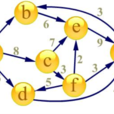SPFA 算法是 Bellman-Ford算法 的佇列最佳化算法的別稱,通常用於求含負權邊的單源最短路徑,以及判負權環。SPFA 最壞情況下複雜度和樸素 Bellman-Ford 相同,為 O(VE)。
基本介紹
- 中文名:貝爾曼-福特算法的佇列最佳化形式
- 外文名:Bellman-Ford using queue optimization
- 簡稱:SPFA
- 全稱:Shortest Path Faster Algorithm
- 引進中國者:段凡丁
原理及證明
 最短路問題
最短路問題代碼形式
Procedure SPFA; Begin initialize-single-source(G,s); initialize-queue(Q); enqueue(Q,s); while not empty(Q) do begin u:=dequeue(Q); for each v∈adj[u] do begin tmp:=d[v]; relax(u,v); if (tmp<>d[v]) and (not v in Q) then enqueue(Q,v); end; end;End;
ProcedureSPFA;Begin initialize-single-source(G,s); initialize-queue(Q); enqueue(Q,s); while not empty(Q) do begin u:=dequeue(Q); for each v∈adj[u] do begin tmp:=d[v]; relax(u,v); if(tmp<>d[v])and(not v in Q)then enqueue(Q,v); end; end;End;
#include<iostream>#include<vector>#include<list>using namespace std;struct Edge{ int to,len;};bool spfa(const int &beg,//出發點 const vector<list<Edge> > &adjlist,//鄰接表,通過傳引用避免拷貝 vector<int> &dist,//出發點到各點的最短路徑長度 vector<int> &path)//路徑上到達該點的前一個點//沒有負權迴路返回0//福利:這個函式沒有調用任何全局變數,可以直接複製!{ const int INF=0x7FFFFFFF,NODE=adjlist.size();//用鄰接表的大小傳遞頂點個數,減少參數傳遞 dist.assign(NODE,INF);//初始化距離為無窮大 path.assign(NODE,-1);//初始化路徑為未知 list<int> que(1,beg);//處理佇列 vector<int> cnt(NODE,0);//記錄各點入隊次數,用於判斷負權迴路 vector<bool> flag(NODE,0);//標誌數組,判斷是否在佇列中 dist[beg]=0;//出發點到自身路徑長度為0 cnt[beg]=flag[beg]=1;//入隊並開始計數 while(!que.empty()) { const int now=que.front(); que.pop_front(); flag[now]=0;//將當前處理的點出隊 for(list<Edge>::const_iterator//用常量疊代器遍歷鄰接表 i=adjlist[now].begin(); i!=adjlist[now].end(); ++i) if(dist[i->to]>dist[now]+i->len)//不滿足三角不等式 { dist[i->to]=dist[now]+i->len;//更新 path[i->to]=now;//記錄路徑 if(!flag[i->to])//若未在處理佇列中 { if(NODE==++cnt[i->to])return 1;//計數後出現負權迴路 if(!que.empty()&&dist[i->to]<dist[que.front()])//佇列非空且優於隊首(SLF) que.push_front(i->to);//放在隊首 else que.push_back(i->to);//否則放在隊尾 flag[i->to]=1;//入隊 } } } return 0;}int main(){ int n_num,e_num,beg;//含義見下 cout<<"輸入點數、邊數、出發點:"; cin>>n_num>>e_num>>beg; vector<list<Edge> > adjlist(n_num,list<Edge>());//默認初始化鄰接表 for(int i=0,p; i!=e_num; ++i) { Edge tmp; cout<<"輸入第"<<i+1<<"條邊的起點、終點、長度:"; cin>>p>>tmp.to>>tmp.len; adjlist[p].push_back(tmp); } vector<int> dist,path;//用於接收最短路徑長度及路徑各點 if(spfa(beg,adjlist,dist,path))cout<<"圖中存在負權迴路\n"; else for(int i=0; i!=n_num; ++i) { cout<<beg<<"到"<<i<<"的最短距離為"<<dist[i]<<",反向列印路徑:"; for(int w=i; path[w]>=0; w=path[w])cout<<w<<"<-"; cout<<beg<<'\n'; }}const maxp=10000;{最大結點數}var{變數定義} p,c,s,t:longint;{p,結點數;c,邊數;s:起點;t:終點} a,b:array[1..maxp,0..maxp]of longint;{a[x,y]存x,y之間邊的權;b[x,c]存與x相連的第c個邊的另一個結點y} d,m:array[1..maxp]of integer;{d:佇列,m:入隊次數標記} v:array[1..maxp]of boolean;{是否入隊的標記} dist:array[1..maxp]of longint;{到起點的最短路} head,tail:longint;{隊首/隊尾指針}procedure init;var i,x,y,z:longint;begin read(p,c); for i:=1 to c do begin readln(x,y,z);{x,y:一條邊的兩個結點;z:這條邊的權值} inc(b[x,0]);b[x,b[x,0]]:=y;a[x,y]:=z;{b[x,0]:以x為一個結點的邊的條數} inc(b[y,0]);b[y,b[y,0]]:=x;a[y,x]:=z; end; readln(s,t);{讀入起點與終點}end;procedure spfa(s:longint);{SPFA}var i,j,now:longint;begin fillchar(d,sizeof(d),0); fillchar(v,sizeof(v),false); for j:=1 to p do dist[j]:=maxlongint; dist[s]:=0; v[s]:=true; d[1]:=s; {佇列的初始狀態,s為起點} head:=1; tail:=1; while head<=tail do{佇列不空} begin now:=d[head];{取隊首元素} for i:=1 to b[now,0] do if dist[b[now,i]]>dist[now]+a[now,b[now,i]] then begin dist[b[now,i]]:=dist[now]+a[now,b[now,i]];{修改最短路} if not v[b[now,i]] then{擴展結點入隊} begin inc(m[b[now,i]]); if m[b[now,i]]=p then begin writeln('no way');halt;end; {同一節點入隊次數超過p,存在負環} inc(tail); d[tail]:=b[now,i]; v[b[now,i]]:=true; end; end; v[now]:=false;{釋放結點,一定要釋放掉,因為這節點有可能下次用來鬆弛其它節點} inc(head);{出隊} end;end;procedure print;begin writeln(dist[t]);end;begin init; spfa(s); print;end.比較
解決實際問題
#include<iostream>#include<cmath>#include<algorithm>#include<cstring>#include<cstdio>#include<string>#include<map>#include<queue>#include<stack>using namespace std;const int MAXN=200+10;queue<int>q;int n,m,p,h[MAXN][MAXN]={0},X,Y;bool yan[MAXN][MAXN];int main(){ int T; cin>>T; while(T--) { memset(yan,0,sizeof(yan)); cin>>n>>m; for(int i=1;i<=n;++i) for(int j=1;j<=m;++j) cin>>h[i][j]; cin>>X>>Y>>p; while(p--) { int a,b; cin>>a>>b; q.push(a*MAXN+b); yan[a][b]=true; } while(!q.empty()) { int x=q.front(),y; q.pop(); y=x%MAXN,x/=MAXN; if(x+1<=n) if(h[x+1][y]<h[x][y]) h[x+1][y]=h[x][y],yan[x+1][y]=true,q.push((x+1)*MAXN+y); if(x-1>0) if(h[x-1][y]<h[x][y]) h[x+1][y]=h[x][y],yan[x-1][y]=true,q.push((x-1)*MAXN+y); if(y<=m) if(h[x][y+1]<h[x][y]) h[x][y+1]=h[x][y],yan[x][y+1]=true,q.push(x*MAXN+y+1); if(y>0) if(h[x][y-1]<h[x][y]) h[x][y+1]=h[x][y],yan[x][y-1]=true,q.push(x*MAXN+y-1); } if(yan[X][Y]) cout<<"Yes"<<endl; else cout<<"No"<<endl; } //system("pause"); return 0;}#include<cstdio>#include<iostream>#include<cstring>using namespace std;struct node{ int x,y,d,next;};int num=0;node v[11100];int first[105];int n;int q[105];int f[105];bool p[105];int start=1,end=2;char map[105][5055];void connect(int x,int y,int d){ num++; v[num].x=x;v[num].y=y;v[num].d=d; v[num].next=first[x];first[x]=num; return; }int main(){ int temp; int ans=0; memset(first,0,sizeof(first)); memset(q,0,sizeof(q)); q[1]=1; memset(f,63,sizeof(f)); temp=f[1];f[1]=0; memset(p,false,sizeof(p)); p[1]=true; scanf ("%d\n",&n); for (int i=1;i<n;i++) { int x=(i+1),y=1,d=0; gets(map[i]); for (int j=0;j<strlen(map[i]);j++) { if (map[i][j]!=' ' && map[i][j]!='x') {d*=10;d+=(map[i][j]-'0');} if (map[i][j]==' ' || j==strlen(map[i])-1) { if (map[i][j-1]!='x' && map[i][j]!='x') { connect(y,x,d); connect(x,y,d); } d=0;y++; } } } while (start!=end) { int x=q[start]; for (int i=first[x];i!=0;i=v[i].next) { int y=v[i].y; if (f[y]>f[x]+v[i].d) { f[y]=f[x]+v[i].d; if (p[y]==false) { q[end]=y; p[y]=true; end++; if (end>n) end=1; } } } p[x]=false; start++; if (start>n) start=1; } for (int i=1;i<=n;i++) { if (f[i]!=temp && f[i]>ans) ans=f[i]; } printf ("%d",ans); return 0;}
